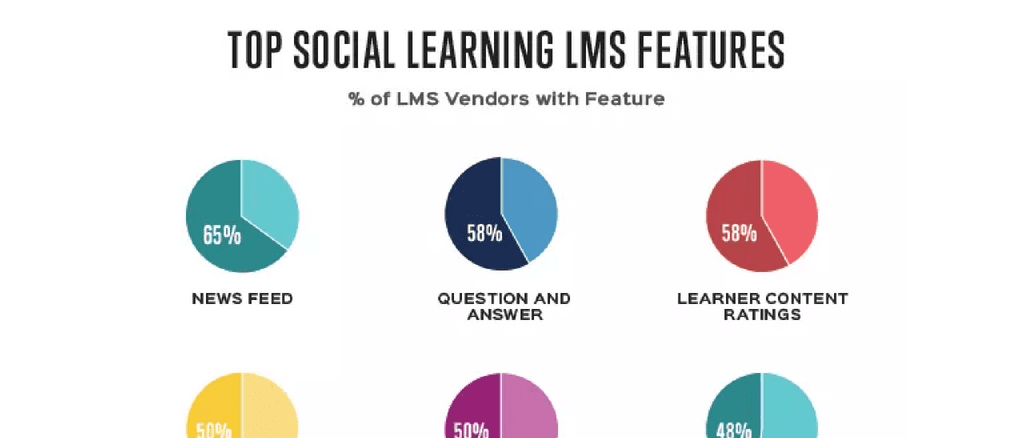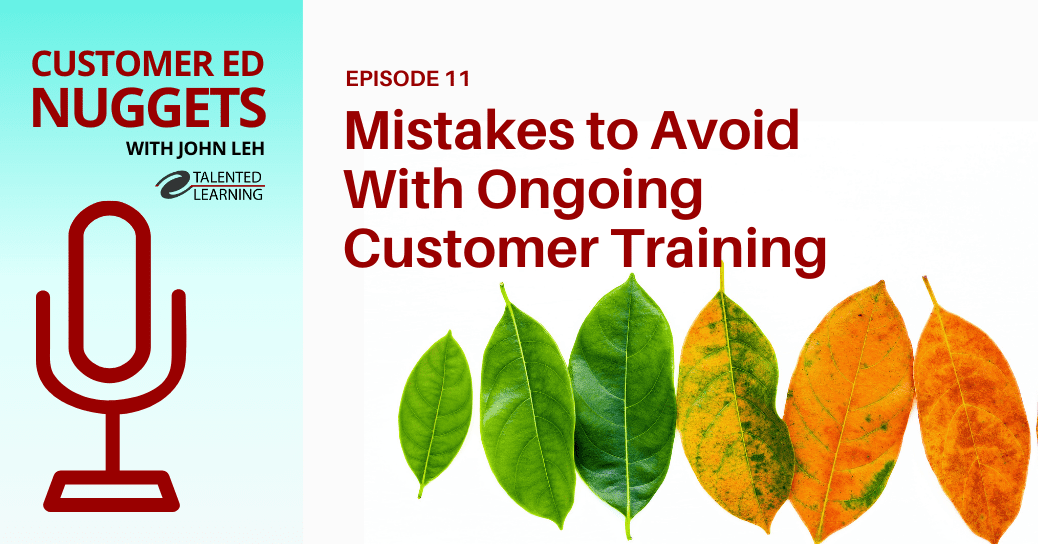
In 2016, most people are accustomed to social media and the conventions associated with profiles, friends, posts, liking and sharing. But how are these new social business behaviors influencing social learning features of today’s learning management systems (LMS)?
We wanted to find out, so we surveyed 74 diverse LMS vendors about the social learning functionality available in their platforms. We targeted the LMS vendor community because these organizations have a vested interest in developing and supporting only the features they believe the market wants and they know they can sell.
To achieve a representative sample of global demand, we limited each LMS vendor to a single survey response. Here is what we found:
What’s Going on with the Social Learning LMS?
Technically, social learning features were built into learning management systems long before social media was invented. In the 1990s, the social LMS feature set included threaded discussions, coffee groups, collaboration centers, forums, FAQ and chat — typically occupying a seldom-used tab in the navigation menu.
In reality, this social LMS feature set was all sales sizzle. Social capabilities were underutilized, mainly because no one understood how to deploy, promote and support them. Common logic was flawed — assuming training professionals and subject matter experts (SMEs) would regularly visit these social “spaces” and interact, keeping content fresh and learner engagement high. Unfortunately, content quickly became stale and learning interaction ceased.
But now, progressive LMS vendors are leveraging the recent business culture shift toward social media to fulfill the promise of social learning. Social functionality has become integral to LMS solutions for extended enterprise, ecommerce and (to a lesser degree) employee LMS solutions. These social LMS features serve many strategic business functions including:
- Community development and on-demand support
- Increased visibility to attract and retain volunteer learners
- Accelerated content curation and knowledge sharing
- Enhanced productivity for workgroups and remote team projects
- Stronger collaboration for self-paced and live instructor content (peer-to-peer and peer-to-instructor)
- Effective drip, drip, drip microlearning and marketing
With these LMS features, organizations have an opportunity to create and sustain learning communities around virtually any topic, course or idea. More importantly, people can leverage all the social behaviors they apply elsewhere to the process of learning. However, there is still tremendous room for improvement in designing and deploying social LMS capabilities. “Best practices” are still very much a work in process.
Proof of Change?
The large Talent Management providers are retaking a serious look at useful social learning after losing many pure LMS opportunities to the socially focused cloud LMSs. For example, when finalizing this post I became aware of the new SAP Jam collaboration learning platform. SAP is attempting to inject social learning into their platforms to adapt to the new way learners want to learn. The big talent LMS providers have been late to the social party– mainly because they focus only on employee development and not extended enterprise solutions where the social ROI is more evident. With the recent announcement by Workday to release their own socially enabled LMS the other Talent providers are now following suit. The behemoth laggards are finally back to investing in learning innovation.
Industry Social Learning LMS Feature Set
In addition to conducting our LMS vendor survey, Talented Learning has also conducted over 100 in-depth LMS reviews in the last two years. We have documented all the social features we encountered and divided them into two groups: basic and advanced complexity.
Basic Social Learning LMS Features
- Billboards and news
- Email and text notifications
- Question and answer tools
- Discussion boards, threaded discussion, forums and best practice centers tied to classes or topics
- Blogs — Often these look more like threaded discussion than WordPress
- “Friending” and “following” – users must become “friends” to share deeper information
- User profile (and ability to see others’ profiles) with bios, user photos, biographies and status tracking visible in LMS
- Ability to like, share and comment on content in catalog
- Ability to create and share content in user profile and in peer newsfeeds
- Ability to recommend content to peers
- Content tagging (new word for keyword metadata) and search by tag
- Most popular content, highly rated content and frequently accessed content
- Find-the-expert functionality with people search and communications via chat or mail
- Allow users to create accounts, log in, port contacts, access feeds using their existing Facebook, LinkedIn, Google+, SharePoint, Twitter or other existing social account credentials
Advanced Social Learning LMS Features
- Integrated social interface – not a separate tab in the LMS
- Intra-content social discussion for learners and teachers
- Newsfeed, leaderboard, “find expert” or other social widgets on user homepage
- Integration with existing corporate social networks (like Yammer or Bloomfire) to share courses on timeline, invite users from contact list and share success in personal feeds
- Post course enrollments, completions, awards, badges, levels or other gamification progress to external social networks to encourage comments, competition and additional enrollments
- Personal activity feeds, journals and news streams
- Ability to provide peer “recommendations” or “kudos”
- Web conference events integrated into social groups – video, screen sharing and recording
- Capture chats, video chats and webinars. Record and use for discussion and continued learning
- Polling and response stats
- Seamless integration with LMS gamification features
- Volume of comments or level of social interaction can be used as criteria for learning activity completion
- Manage social engagement of users and have relative scores for users (more engagement = higher score)
Conclusion
Use of mainstream social media has been the guiding force for social learning LMS relevance. New and progressive cloud LMS providers have been integrating the best of social media features with social learning — and guess what? It’s working.
These features don’t replace popular social channels and tools nor are they intended to do so. However, with more sophisticated social capabilities integrated into LMS platforms, organizations are finally able to create sustainable learning communities within an LMS environment. And that means the long-awaited benefits of more continuous, holistic formal and informal learning are beginning to be realized.
Thanks for reading!
WANT TO LEARN MORE? JOIN OUR MAY LIVE WEBINAR:
How to Drive Online Learning at Scale: Corporate Market Strategies for Associations
Selling online learning content to individuals is challenging enough. But selling that same content in bulk through corporate customers or partners can be even more demanding. The business models are fundamentally different. Plus, business-to-business relationships require specialized content management functionality.
What does it take to succeed?
Join John Leh, CEO and Lead Analyst at Talented Learning, as he hosts a live virtual panel with experts who have developed and managed profitable B2B online education programs:
- William Hold, Chief Development Officer, The National Alliance for Insurance Education and Research
- Linda Bowers, CTO, WBT Systems
In this dynamic one-hour roundtable, you’ll learn how to:
- Build a viable business model for bulk sales
- Develop effective pricing and marketing strategies
- Compare tradeoffs of selling through sales reps versus online channels
- Delegate content administration, reporting and user provisioning
- Integrate core learning systems with CRM platforms and other operational applications
- Achieve internal buy-in, drive project momentum and maintain organizational alignment
All live webinar attendees will receive 1 credit toward a Certified Association Executive (CAE) credential application or renewal.
Need Proven LMS Selection Guidance?
Looking for a learning platform that truly fits your organization’s needs? We’re here to help! Submit the form below to schedule a free preliminary consultation at your convenience.
Share This Post
Related Posts
The Future of Customer Education: Customer Ed Nugget 16
Customer education is rapidly evolving as organizations embrace new strategies and tech. What does this mean for the future of customer education? See what experts say on this Customer Ed Nuggets episode
Education Strategy Mistakes to Avoid: Customer Ed Nugget 15
What does it take to deliver a successful customer education program? It starts with a solid education strategy. Learn how to avoid common pitfalls on this Customer Ed Nuggets episode
Which LMS is Best for You? New Shortlisting Tool for 2024
How can you find the best learning system for your business? Our LMS shortlisting tool can help. Learn about the 2024 RightFit Solution Grid. Free, reliable guidance based on our independent research
How to Build a Learning-Based Business: Executive Q&A Notes
Building and selling online courses may seem easy, but building a profitable learning-based business is far more complex. Find out what successful leaders say about running this kind of business
The Rewards of Community Building: Customer Ed Nugget 14
What role does community play in your customer relationships? Find out why community building is such a powerful force in customer education on this Customer Ed Nuggets episode
Benefits of Training Content Syndication: Customer Ed Nugget 13
If you educate customers online, why should you consider content syndication? Discover 10 compelling business benefits in this Customer Ed Nuggets episode
Top Marketing Skills to Master: Customer Ed Nugget 12
Successful customer education programs depend on professionals with expertise in multiple disciplines. Which marketing skills lead to the best results?
How to Measure and Improve Partner Training ROI
An educated channel is a successful channel. But how do you know if your educational programs are effective? Learn from an expert how to evaluate partner training ROI
Mistakes in Ongoing Customer Training: Customer Ed Nugget 11
Customer education doesn't stop with onboarding. It pays to invest in ongoing customer training. Learn which mistakes to avoid in this Customer Ed Nuggets episode















FOLLOW US ON SOCIAL